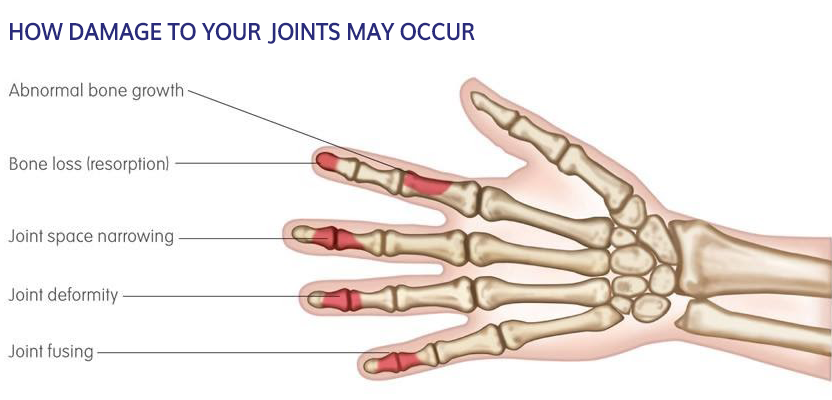Psoriatic Arthritis
WHAT IS PSORIATIC ARTHRITIS?
Psoriatic arthritis (PsA) is an inflammatory condition caused when a person’s own immune cells attacks their joints. It develops in some people with the skin condition psoriasis, and typically causes affected joints to become inflamed (swollen), painful and stiff.
PsA affects approximately two in 1000 people in the general population and approximately 20-25% of people with psoriasis will develop the condition.1,2 In most cases, the psoriasis develops before the arthritis, sometimes by years. PsA most often develops between the ages of 30 to 50.3 Around one in three people who have psoriasis and not PsA will also have pain and stiffness in their neck or back.3
Psoriatic arthritis can take many forms and it can affect almost any joint in the body, including the joints of the spine and the neck. The inflammation begins around the edges of the joints and, if left untreated, it can lead to swelling in the joints and permanent damage to bone and cartilage.
The longer inflammation lasts in a joint, the greater the risk of damage. For this reason it is important to seek a diagnosis as early as possible so that treatment can be given before damage occurs.
WHAT ARE THE SYMPTOMS?
In the early stages of disease, inflammation causes pain, stiffness, and swelling in and around the joints. PsA may affect the spine, hands, shoulders, elbows, feet, knees, or ankles.
Symptoms may include:
- Swollen joints (although they can look normal)
- Joint stiffness and pain (especially in the morning)
- Raised, red patches, often with a silvery scale (known as psoriatic skin lesions)
- Overall fatigue/tiredness and a feeling of being unwell (sometimes people with PsA just think they have had a long bout of the flu)
Psoriatic arthritis can develop slowly with mild symptoms. On the other hand, it can develop quickly and become serious. This is why early recognition, diagnosis and treatment of psoriatic arthritis is essential. This early effort can help prevent or limit joint damage.

In 60-80% of people with PsA, psoriasis occurs before joint disease.4 If you have been diagnosed with psoriasis, it is important to tell your GP or skin specialist immediately if you have any aches and pains.
References
- Gladman DD, Ritchlin C. Clinical manifestations and diagnosis of psoriatic arthritis. Accessed from: http://www.uptodate.com/contents/clinical-manifestations-and-diagnosis-of-psoriatic-arthritis (Last accessed August 2023)
- Alinaghi F, Calov M, Kirstensen LE, et al. Prevalence of psoriatic arthritis in patients with psoriasis: A systematic review and meta-analysis of observational and clinical studies. J Am Acad Dermatol 2019;80(1):251–265.
- Arthritis New Zealand. Psoriatic Arthritis Fact Sheet. Accessed from https://www.arthritis.org.nz/forms-of-arthritis/psoriatic-arthritis/ (Last accessed August 2023)
- Hammadi A.A, Diamond H.S., et al. Psoriatic Arthritis. Accessed from: http://emedicine.medscape.com/article/2196539-overview (Last accessed August 2023)


TREATMENT OPTIONS
Because there is no cure for PsA just yet, treatment is aimed at reducing its impact. Different treatments may aim to:
- Reduce pain and inflammation
- Lessen or prevent joint damage
- Keep joints as flexible as possible
MEDICATIONS
Medications used in the treatment of PsA include:
Medication for pain and inflammation:
Non-steroidal anti-inflammatory drugs – or NSAIDs for short – can help to reduce the pain and stiffness associated with inflammation. They are usually taken after food to reduce the likelihood of an upset stomach. There are some people who shouldn’t take NSAIDs so you should check with your doctor or pharmacist before taking them.
Steroids:
The most commonly used example is prednisone. These drugs suppress the immune system and shut down the inflammatory process. Steroids are generally used to bring the disease under control while waiting for other treatments to take effect. Steroids are used usually as short courses because of the risk of side effects from long-term use.
Disease Modifying Anti-rheumatic Drugs (DMARDs):
DMARDs including methotrexate, sulfasalazine and leflunomide can be used to reduce symptoms of inflammation, and can slow down disease progression and risk of damage in the long term. They are particularly effective if taken soon after your symptoms first appear.
Biologic medicines:
Biologic medicines are used when other medications have been tried but severe symptoms are still present. Medicines like Enbrel® are made from human proteins that get right to the source of the problem. Enbrel® catches on to and restrains another protein already in your body called tumour necrosis factor (TNF), which is a naturally occurring chemical messenger in your bloodstream. Too much TNF often plays a part in causing the painful swelling and redness around your joints in rheumatological conditions. Enbrel® works by helping to block the effects of too much TNF, which means that it cannot start the process that leads to inflammation.
SURGERY
Surgery may be needed when pain is severe or when deformities are disabling. For example, deformed joints in the feet may make it painful and difficult to walk, while deformities in the hands may make everyday tasks difficult.
COMPLEMENTARY THERAPIES
Some people find meditation, acupuncture and other natural therapies helpful in managing symptoms. These treatments are generally safe when taken alongside conventional treatments, but you should discuss this with your doctor. There is no evidence that these therapies provide any long-term benefits so it is usually best to combine them with medical treatments.
EXERCISE
Exercise can strengthen your muscles, protect your joints and keep your joints flexible. Your physiotherapist will be able to recommend suitable exercises. An occupational therapist can show you ways of doing tasks that will keep you independent.
LIFESTYLE
- Eat a healthy balanced diet
- Maintain a healthy weight
- Moderate your alcohol consumption; your doctor or rheumatologist can tell you how much is safe for you.
- Give up smoking
For more information and support on how to quit smoking, phone Quitline 0800 778 778 or visit www.quit.org.nz
SUPPORT
Psoriatic arthritis doesn’t mean you can’t get on with your life. Arthritis New Zealand has helped thousands of people do just that.
Arthritis New Zealand
PO Box 10-020
Wellington
Freephone 0800 663 463
www.arthritis.org.nz
If you need further assistance with Enbrel® administration, or have questions about your condition or treatment, contact your healthcare professional, or call 0800 Enbrel® (0800 362 735).
Enbrel® is a registered trademark - © Pfizer 2023.

